Most businesses – and the business owners behind them – understand the importance of consistency in branding. This is why we can now expect a consistent user experience whether we are browsing a brand’s e-commerce site or its social media profiles. The similarities in look and feel are there on purpose, all for the sake of maintaining a consistent branding message.
The same elements need to be present in offline experiences as well. This means retail spaces and the interior of the brand’s office need to display elements that are in line with the brand and the culture behind it.
Culture and branding are quickly becoming important elements of good interior design in the commercial landscape. Fortunately, there is a growing number of ways these elements can be integrated with the interior design of your office or retail space.
Start with Colours
A brand has several elements to it, and colours are among the most important elements that get recognized often. Brands use colours for different purposes. You will notice how food-related brands use a lot of orange and red, while tech brands prefer yellow and green. Colours have different meanings – and create different feels – depending on how they are used.
It is also worth noting that colours are the easiest brand elements to integrate with interior design. After all, a good interior design process always starts with setting a colour scheme. Pick a handful of colours that are in line with the culture and branding objectives and stick with those colours across the design.
Colours can be used differently too. You don’t always have to settle for large walls in the brand’s colours just to accentuate the key messages of your brand. You can, for instance, add touches of green if your brand uses green as the primary colour. Those touches can be anything from accents and lines to interior elements such as artwork and flooring.
A Layout That Speaks
The layout of the commercial space also matters, particularly when it is an office space designed to promote a certain corporate culture. The latest trend is open offices with little to no border, but the approach may not suit your corporate culture. There is nothing wrong with choosing other layouts that best meet your objectives.
Instead of an open office, for example, you can go with an open space for employees, surrounded by cubicles or private offices for managers and executives. This layout accentuates how executives and management are there to protect employees and provide them with the most suitable working environment for them to thrive.
A series of private offices designed according to the company’s workflow works too. Compartmentalisation isn’t always bad, especially when such compartmentalisation is also a part of the way the company operates. Rather than being bad, the layout actually plays to the strengths of the company and amplifies those strengths further.
Adding the Actual Brand
Some companies go as far as creating custom wallpaper with their logos on it, but this isn’t necessarily how you want to expose employees to the brand they are working for. In fact, the approach is counterintuitive in most situations. What you want to do instead is add the brand in a way that lets employees appreciate its presence.
Adding a large logo to the entrance of the space is a good start. Make sure the placement is strategic, depending on the feel you want to produce. Placing the logo at eye level, for example, amplifies employees’ sense of ownership and belonging. Placing the logo slightly higher motivates the employees to achieve more and introduces a sense of pride.
These little details matter. The same details also influence how employees feel about the brand. Combined with corporate communications, HR strategies, and how employees are being treated as the company’s biggest assets, there is a lot you can achieve by adding the brand – its logo and brand elements – to the space.
Maintain Your Values
There is an endless array of interior design styles and approaches to add to the commercial space. You can go bohemian with your choice of furniture and the design of the interior as a whole. You can also go for a more minimalistic design and create a modern space for employees and customers. Which style you incorporate, it must also be in line with the brand.
If you have a brand that targets A and B demographics or if your brand, by nature, has a classic feel to it, going with minimalistic interior design may not be the way to go. Yes, employees will still love a clean and decluttered office, but a white office doesn’t go well with a brand that screams classic luxury and provide VIP treatments to its customers.
On the other hand, a sparkly interior with pop elements isn’t going to match the values of a business solutions company. Even worse, this type of interior – when paired with a high-tech, minimalistic brand – actually creates a conflicting message, making it more difficult for employees to align themselves with the corporate culture.
Style AND Substance
If you think interior design is about style more than substance, you are mistaken. A good interior design promotes both equally well and uses both elements to achieve a predefined – mostly common – objective. You can achieve one or the other; you can balance both just as easily. In the case of designing an interior to match your brand and culture, the objectives of the brand take precedent.
You need to ask yourself whether your brand and the culture it represents is more about efficiency and effectiveness or creativity and common goals. You can then put emphasis on those elements to get closer to the objectives you want to achieve.
A space designed for creative employees can certainly benefit from more visual elements, touches of colours, and a layout that promotes freedom at work. You can even tweak the interior design for maximum creative stimulations, such as by adding artwork to certain areas or by using visual elements in others. The opposite is true as well.
Leave Some Air
The one thing you can always benefit from is negative space. Regarding what you are trying to achieve with the interior design – and the key culture and branding messages you want to convey – a cluttered workplace or commercial space is never the answer. No customer will enjoy shopping in a cluttered store, just like no employees will be at their best when working in a cluttered office.
You want to keep that airy feel alive by leaving plenty of empty and negative space. That space under the desk, when left open, actually creates a roomy feel to the entire area. The same can be said for using shorter dividers to leave more vertical space; it creates the illusion of space and makes the ceiling appears higher than it really is.
Even when adding your brand identity to the space, you can return focus to it by leaving enough empty space around the logo or brand element. You can combine the use of space with other elements such as leading lines and colours to really make the brand pop; just like before, the technique works on both customers and employees.
Let There Be Light
The last element to get right is lighting. In order to create a space that really amplifies your culture and your brand, you need to incorporate a suitable lighting setup to the area. There is a simple rule to follow in this respect: use natural light as much as possible. Even with LED lights offering more features and higher efficiency, nothing beats sunlight coming through large windows.
Natural light during the day can be paired with soft light for the evening. Many commercial spaces now use LED T8 or T12 bulbs on the ceiling for maximum brightness and sufficient softness, but this isn’t the best solution for every brand. You have the option to go with other alternatives – such as concealed LED strips or well-placed LED bulbs – to create different feels.
The lighting in your commercial space will dictate the ambience of the space, and that ambience needs to stay true to the culture and the brand. If your brand isn’t meant for bright spaces and white interiors, nothing should stop you from adding mood lighting and creating dark spaces to introduce depth. At the end of the day, all that matters is consistency across the board.
One last secret to keep in mind when designing interiors for business use: comfort is king. Whether it is for pampering the customers or boosting the productivity of employees, a space where they can feel comfortable really helps. Think about comfort every step of the way and you are all set.
If you still want to know more about how to keep interior design in line with culture and branding, Amos Beach, a leading design agency for offices and commercial interior, has more tips for you to follow.
In the meantime, use the elements we discussed in this article to shape a commercial space that takes your brand – and the culture it represents – to a whole new level.





